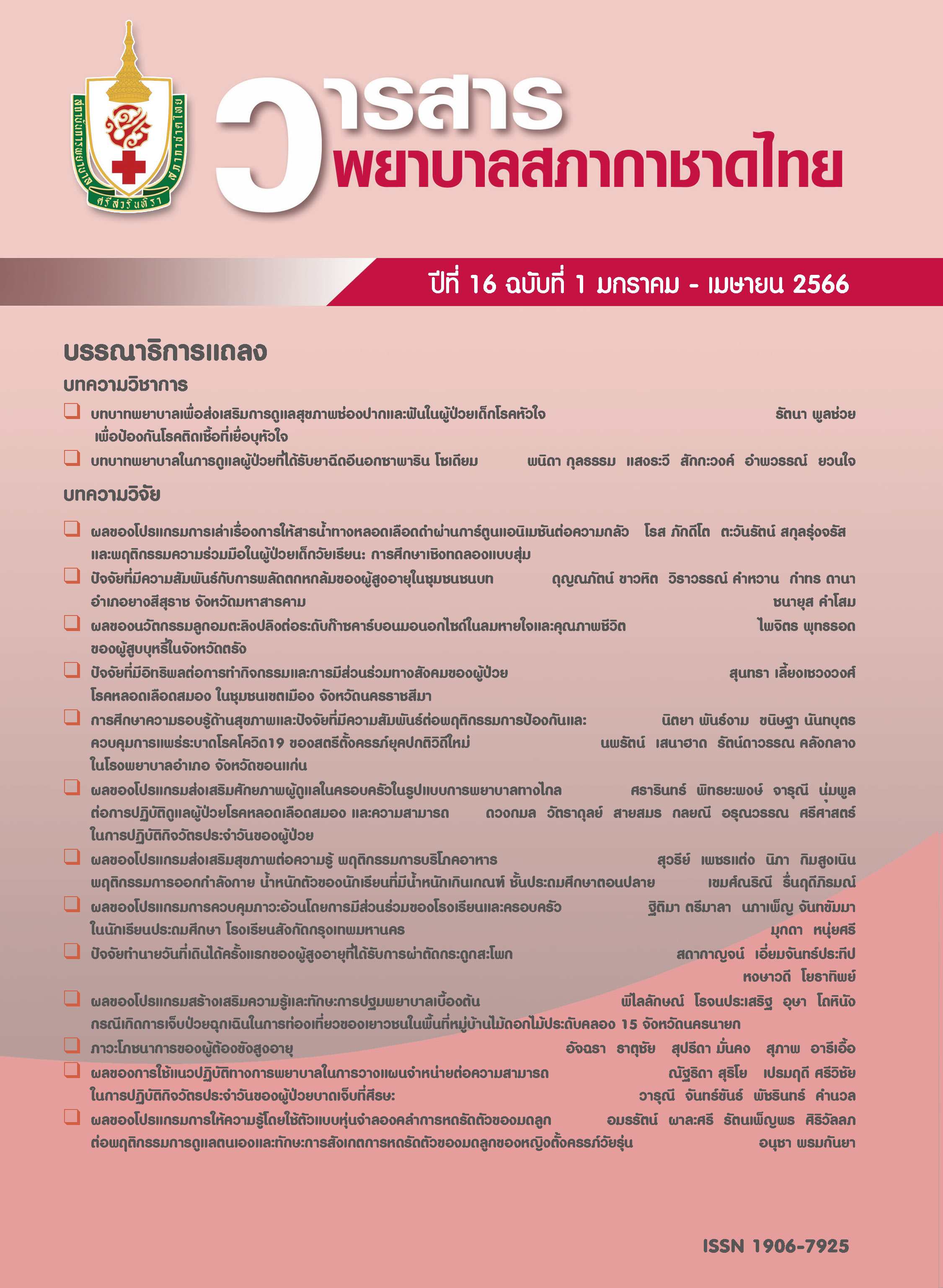Effect of Innovation Bilimbi Candy on Exhaled Carbon Monoxide Level and Quality of Life Among Smokers, Trang Province
Keywords:
innovation bilimbi candy, quality of life, smokersAbstract
This research was quasi-experimental research with two groups measuring the before and after effects of Innovation Bilimbi candy on the exhaled carbon monoxide level and quality of life of smokers. The sample consisted of 52 smokers who came to receive service at Fahsai Clinic in the Trang Community Hospital; the smokers were divided into an experimental group and a control group, with 26 patients each. The tools used for data collection were (1) a general information questionnaire, (2) a quality of life questionnaire, (3) an immortal child eating diary, and (4) an exhaled carbon monoxide level meter. Data were analyzed using descriptive statistics, the mean score difference of the experimental group before and after using Wilcoxon signed-rank test statistic, and the mean score difference between the experimental group and the control group using Mann-Whitney U test.
The results revealed that the experimental group after using immortal leeches had a mean exhaled carbon monoxide level lower than before using the Bilimbi candy, the mean quality of life score showed a statistically significant increase (p < .05), and after consuming the Bilimbi candy, the mean scores of the exhaled carbon monoxide level by the experimental group were lower than those in the control group, while the mean score of quality of life of the experimental group was higher than the control group. These results were statistically significant (p < .05). Drug nurses or psychiatric nurses could use immortal leeches to assist in the treatment of those who wanted to quit smoking and reduce their craving for cigarettes.
References
World Health Organization (WHO). Smoking statistics worldwide retrieved [Internet]. 2016 [cited 2020 Oct 22]. Available from: https://worldpopulationreview.com/countryrankings/smoking-rates-by-country (in Thai)
Center for Research and Knowledge Management for Tobacco Control. Statistics and losses from smoking in Thailand [Internet]. 2016 [cited 2018 May 31]. Available from: https://www.nationtv.tv/main/content/3785499583 (in Thai)
Trang Provincial Public Health Office. Statistics on smoking in the province [Internet]. 2017 [cited 2019 Apr 20]. Available from: http://www.tro.moph.go.th/index2.php. (in Thai)
Sirirasamee B, editor. A guide to the treatment of tobacco addiction for nurses. Bangkok: Monpriya Carfic; 2016. (in Thai)
Pitayarangsarit S, Pankrachang P, editors. Report on the country’s tobacco consumption statistics Thailand 2018. Bangkok: Tobacco Control Research and Knowledge Management Center; 2018 (in Thai).
Tipyawong T. An efficacy study of 0.5% sodium nitrate compared with Vernonia cinerea (L.) Less. for reducing nicotine withdrawal symptom of smoking cessation in IPD at PMNDAT. Royal Thai Army Medical Journal 2021;74(1):3-11. (in Thai)
Kazemzadeh Z, Manzari ZS, Pouresmail Z. Nursing interventions for smoking cessation in hospitalized patients: a systematic review. Int Nurs Rev 2017;64(2):263-75. doi:10.1111/inr.12320
Mondino M, Luck D, Grot S, Januel D, Suaud-Chagny MF, Poulet E, Brunelin J. Effects of repeated transcranial direct current stimulation on smoking, craving and brain reactivity to smoking cues. Sci Rep 2018;8(1):8724. doi: 10.1038/s41598-018-27057-1.
Sirijanya N, Rachakhom J, Thamnithis N, Wannaret T, Supayong R, Pannoii S, et al. Smoking behavior and nicotine addiction among security guards. Thai Journal of Nursing 2018;67(1):19-26. (in Thai)
Pantaewan P. Self-efficacy theory and smoking cessation. J Royal Thai Army Nurses 2017;18(3): 35-43. (in Thai)
Srimorakot P. Alternative therapies to help quit smoking in the Thai way. Nonthaburi: Up True You Cree; 2018. (in Thai)
Junmoon B, Pornchaikate Au-Yeong A, Yoottrai P. Brief intervention for smoking reduces or cessation in adult TS: evidence-based nursing. Journal of Public Health Nursing 2013;20(1):61-73 (in Thai)
Naijitra C, Cheoymang A. Evaluation of antioxidant activity, total phenolic and nicotine contents of 15 Thai herbs. Thai Journal of Science and Technology 2016;24(2);351-61. (in Thai)
Nuket B, et al. Herbal therapy. Nonthaburi: Praboromarajchanok Institute Welfare Project; 2008. (in Thai)
Polit DF, Beck CT. Nursing research principles and methods. 7th ed. Philadelphia: Lippincott Williams & Wilkins; 2004.
Mahatnirankul S, Tantipiwatanasakul W, Pumpaisanchai W, Wongsuwan K, Manarangkun W. World Health Organization Quality of Life Brief–Thai, WHOQOL-BREF-THAI [Internet]. 2014 [cited 2016 Feb 10]. Available from: http://www.dmh.go.th/test/(in Thai)
Covita. piCO+ Smokerlyzer: operating manual [Internet]. 2011 [cited 2019 Apr 20]. Available from: https://www.covita.net/wp-content/uploads/2019/09/pico-manual.pdf
Thailand Innovation Portal. Inventions in food products [Internet]. 2020 [cited 2022 Sep 15]. Available from: www.thailandinnovationportal.com/info/innovation/item/24969 (in Thai)
The 7th National Smoking and Health Conference [Internet]. 2008 [cited 2018 Dec 30]. Available from: www.trc.or.th/th (in Thai)
Ampaipun U, Chanmolee S, Suwan P. The development of smoking cessation model for the elderly in Sub-district health promotion hospital of Nakorn Pathom province. Journal of Social Science and Buddhistic Anthropology 2020;5(3):2-19. (in Thai)
Sutitiwanich P. Quality of life of chronically patients with tobacco dependence in smoking cessation clinic, Chaiyaphum medical hospital. Chaiyaphum Medical Journal 2018;38(2):24-35. (in Thai)
Downloads
Published
Issue
Section
License
Copyright (c) 2023 Srisavarindhira Thai Red Cross Institute of Nursing

This work is licensed under a Creative Commons Attribution-NonCommercial-NoDerivatives 4.0 International License.
เนื้อหาบทความหรือข้อคิดเห็นต่างๆ ในวารสารพยาบาลสภากาชาดไทยนี้ เป็นความคิดเห็นของผู้เขียนบทความ ไม่ใช่ความเห็นของกองบรรณาธิการ หรือสถาบันการพยาบาลศรีสวรินทิรา สภากาชาดไทย






